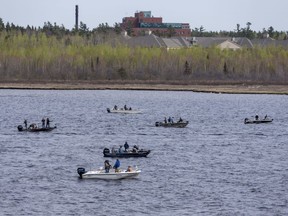Letters: Balance in fishery needed to protect stock

Article content
Striking a balance with striped bass
The remarkable and astonishing recovery of striped bass in the southern Gulf of St. Lawrence represents one of most significant success stories in New Brunswick’s fish and wildlife history. In 1992 the spawning population numbered less than 5,000 striped bass. Today, estimates place the spawning population into the hundreds of thousands.
In nature, a rapid increase in abundance of one species usually has consequences for others. The Miramichi estuary, where salt water mixes with fresh, sustains a wide variety of fish species. Established fish stocks like speckled trout, gaspereaux and smelt, are readily available prey for the larger and voracious striped bass.
Atlantic salmon offers the best example of the change that is occurring.
Striped bass spawning occurs in early June, where they school en masse in the Miramichi estuary. Coincidentally, this is also about the same time as juvenile salmon (known as smolt) begin their incredible migration from freshwater juvenile rearing habitat to offshore areas to return one to three years later as mature salmon.
Unsurprisingly, recent studies indicate unusually high smolt mortality during their migration through the Miramichi estuary. An alarming 95 per cent of the smolt from Northwest Miramichi River and its tributaries are not surviving. To compare, neighbouring salmon rivers where there isn’t a bass spawning population are seeing 10 per cent smolt mortality rates. The number of returning mature Miramichi salmon has fallen below that required to safely sustain the population. Survival of the famed Miramichi Atlantic salmon is threatened.
Angling has generated about $20 million dollars annually and supported hundreds of jobs. While there is no data for the season, striped bass has quickly become a major economic contributor, generating about $4 million in one six-day derby alone.
Dramatic trade-offs between striped bass and other species are neither necessary nor sustainable. In 2019, the House of Commons Committee on Fisheries and Oceans recommended the restoration of balance between fish species in Miramichi estuary. Fish and game organizations, First Nations, and commercial fishers have raised similar concern, but now it is with a much greater sense of urgency.
Fisheries researchers cannot predict the impacts of species interactions with sufficient certainty for fisheries managers to address predator-prey relationships. The fisheries management challenges, in the absence of science advice, are to significantly reduce striped bass numbers, through fishing and cautious monitoring, and to restore Atlantic salmon so it and all fish stocks may benefit the region for years to come.
Now is the time for hard decisions. Establishing balance requires bold action. The collapse of the Miramichi’s Atlantic salmon stock is simply unthinkable.
David Dunn
Chair, Fisheries Committee
New Brunswick Wildlife Federation











Postmedia is committed to maintaining a lively but civil forum for discussion. Please keep comments relevant and respectful. Comments may take up to an hour to appear on the site. You will receive an email if there is a reply to your comment, an update to a thread you follow or if a user you follow comments. Visit our Community Guidelines for more information.